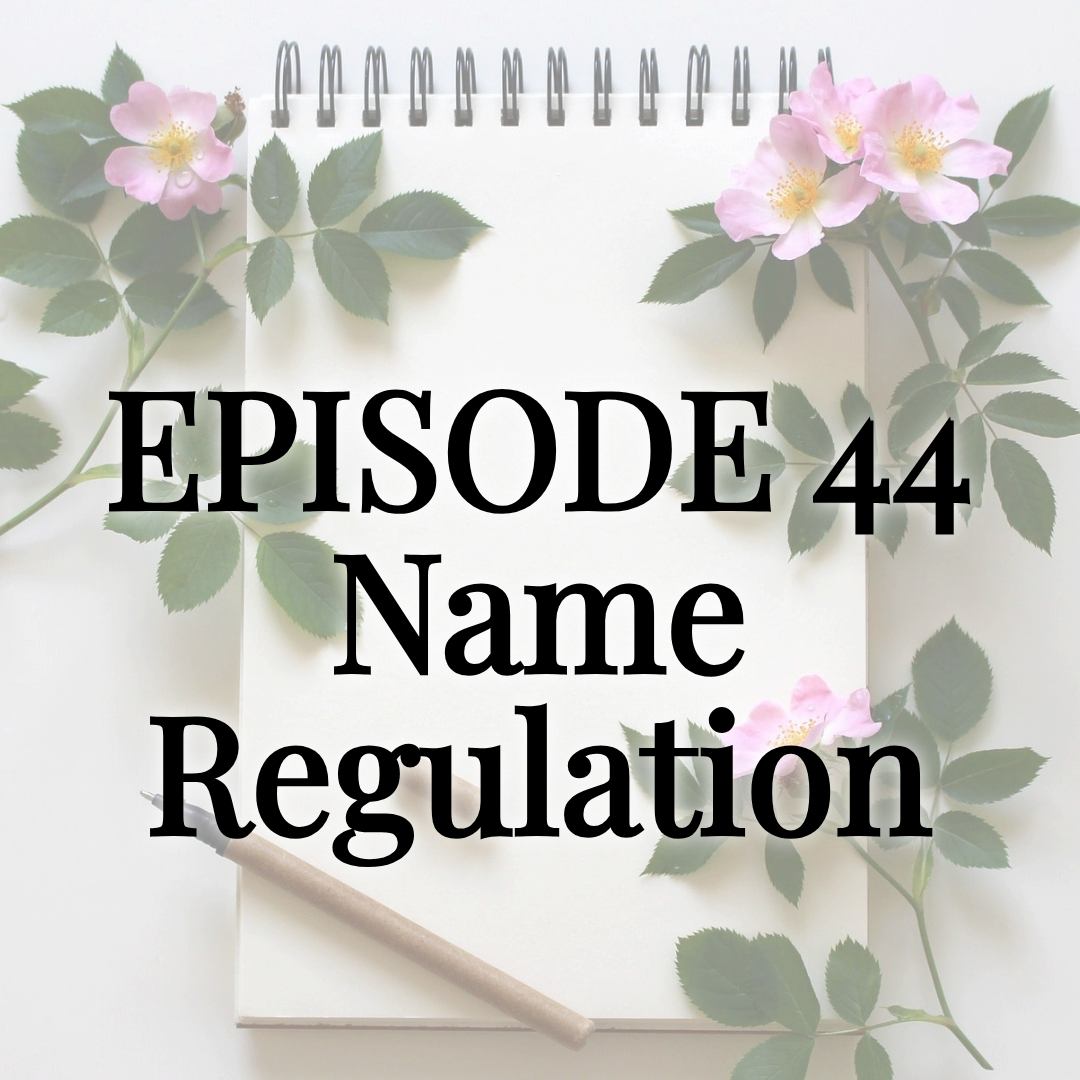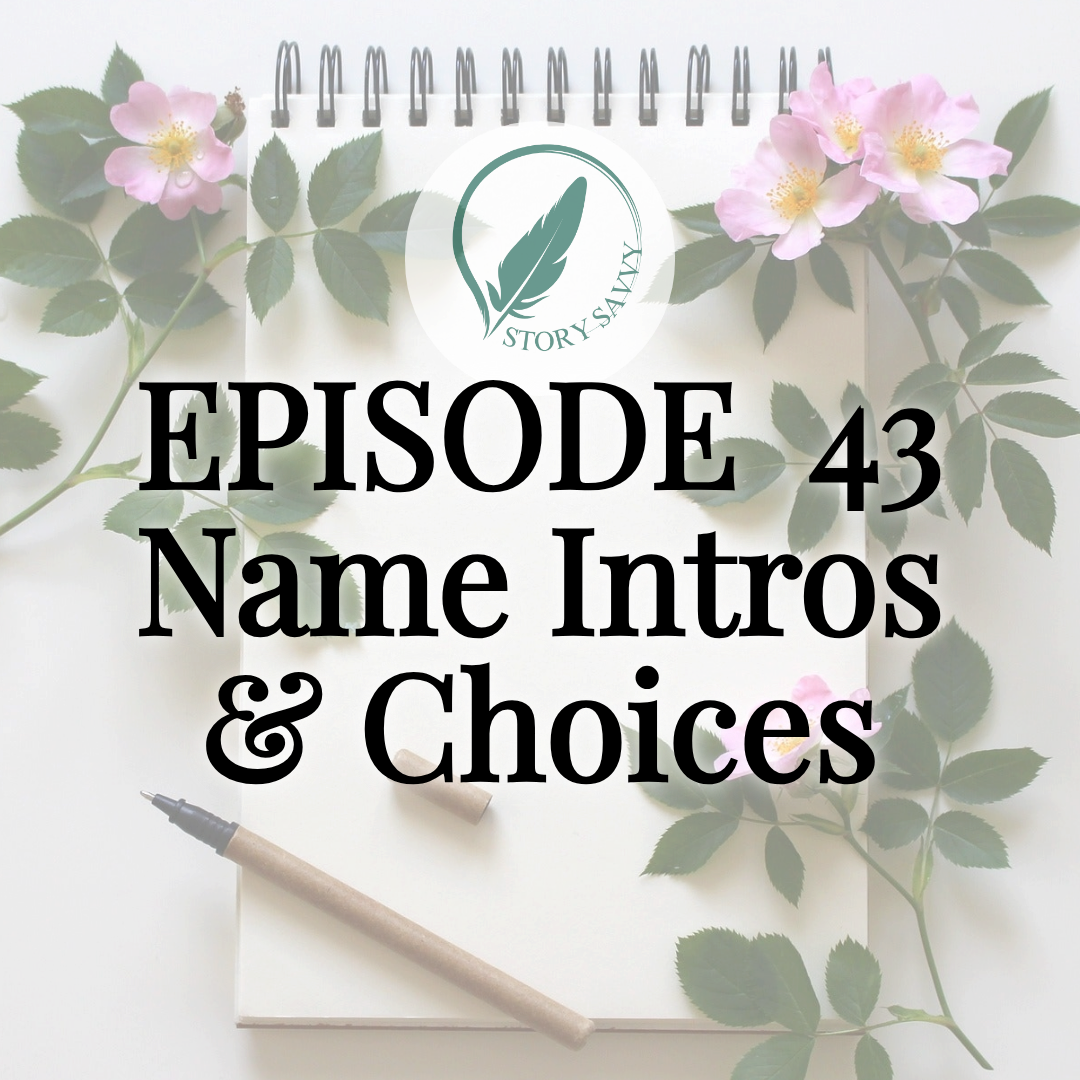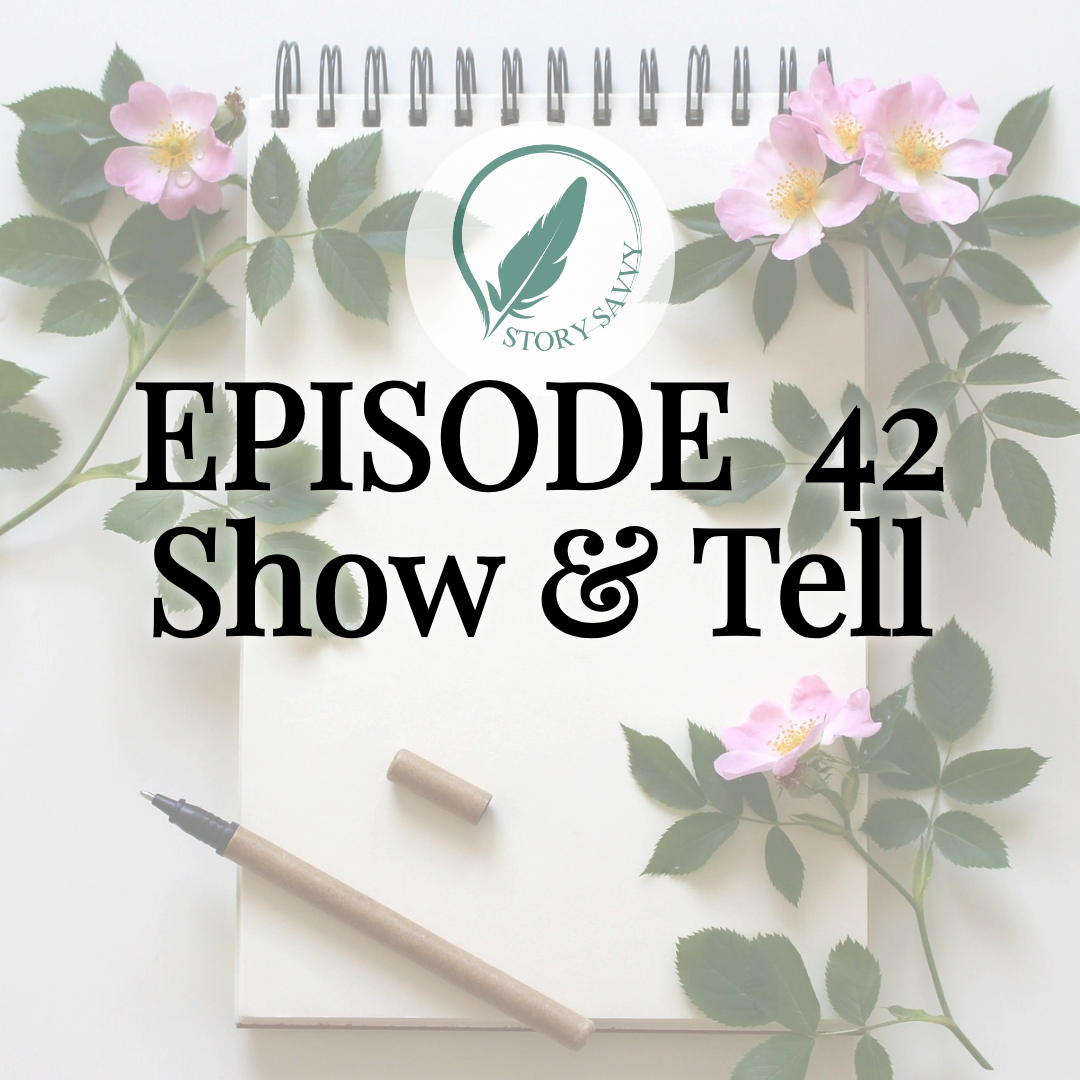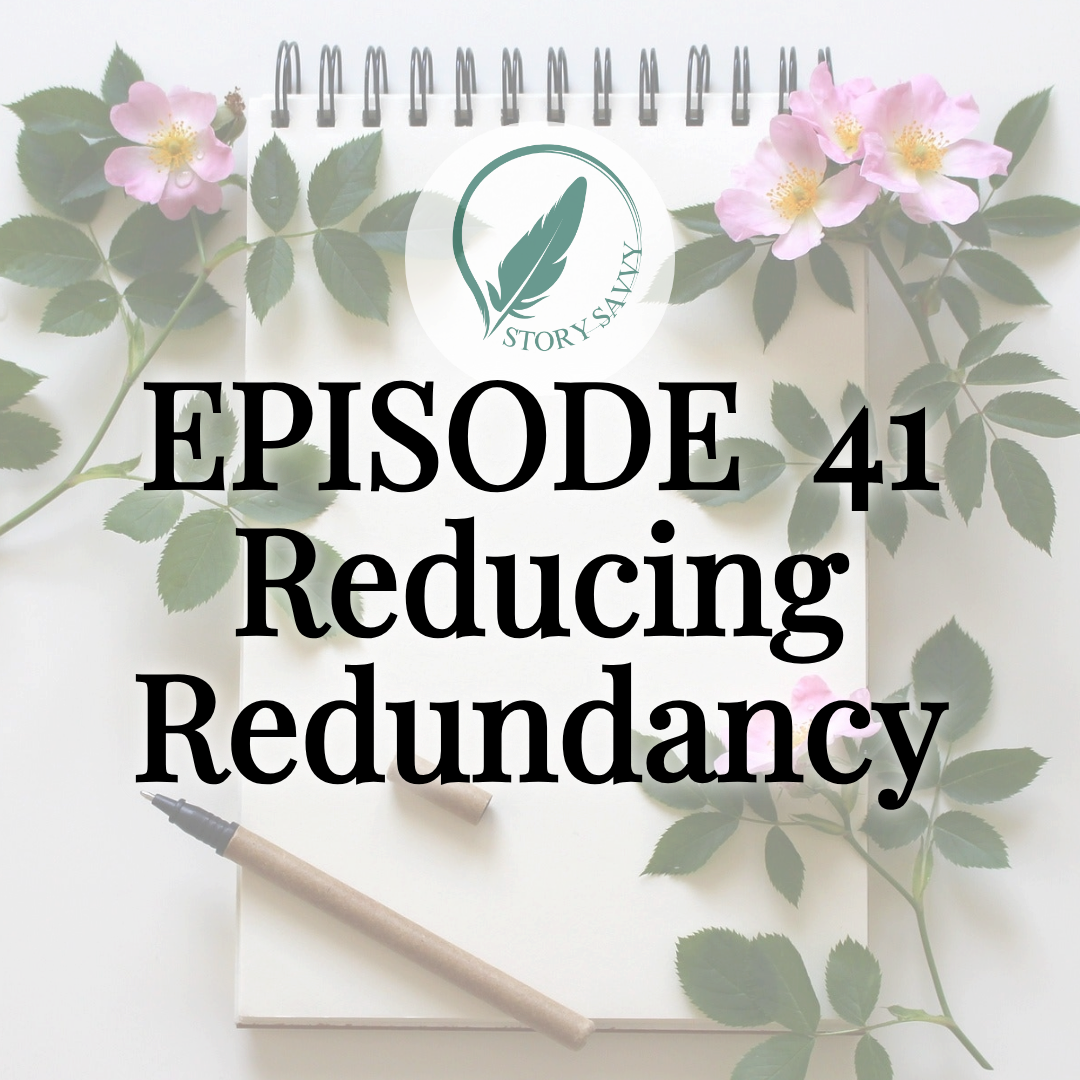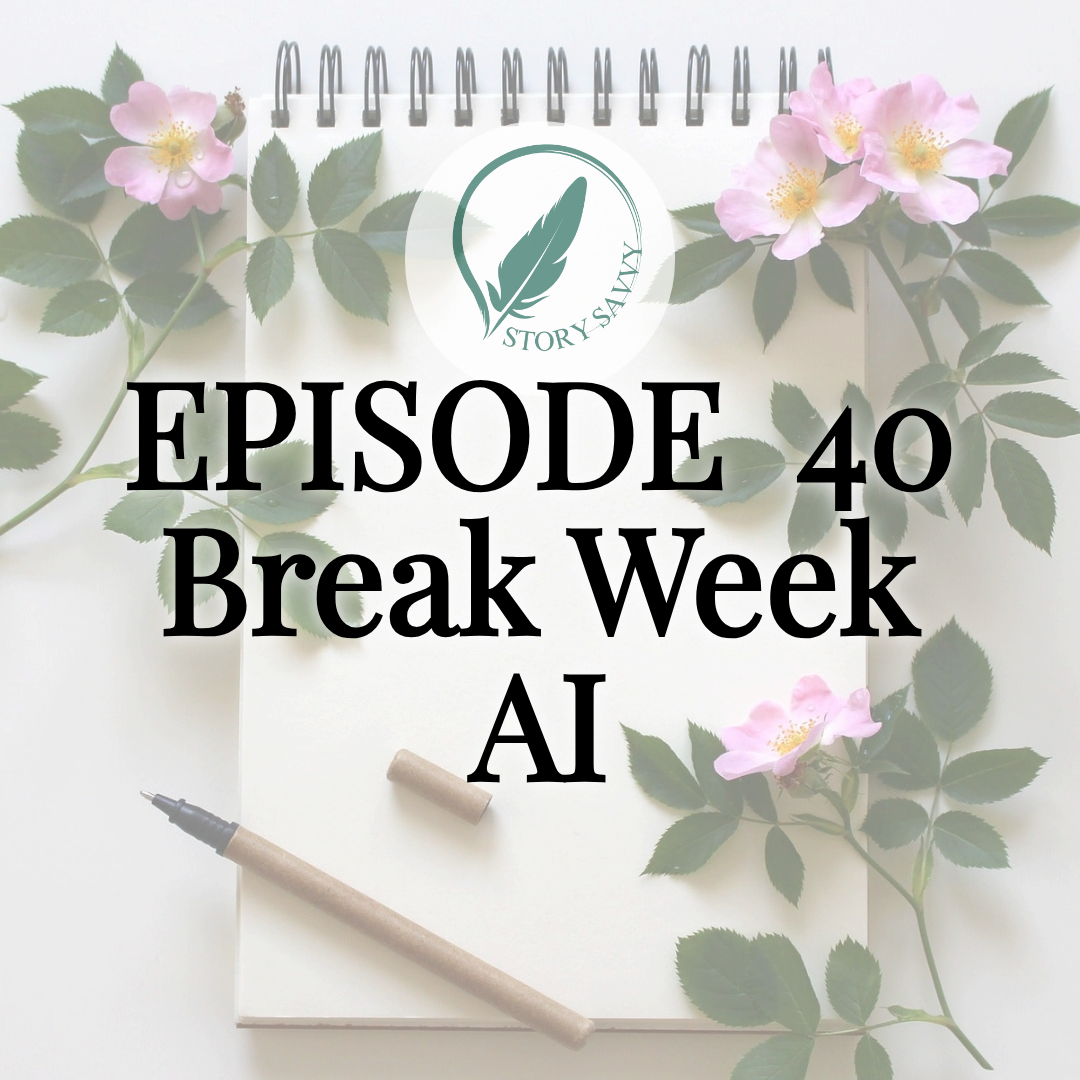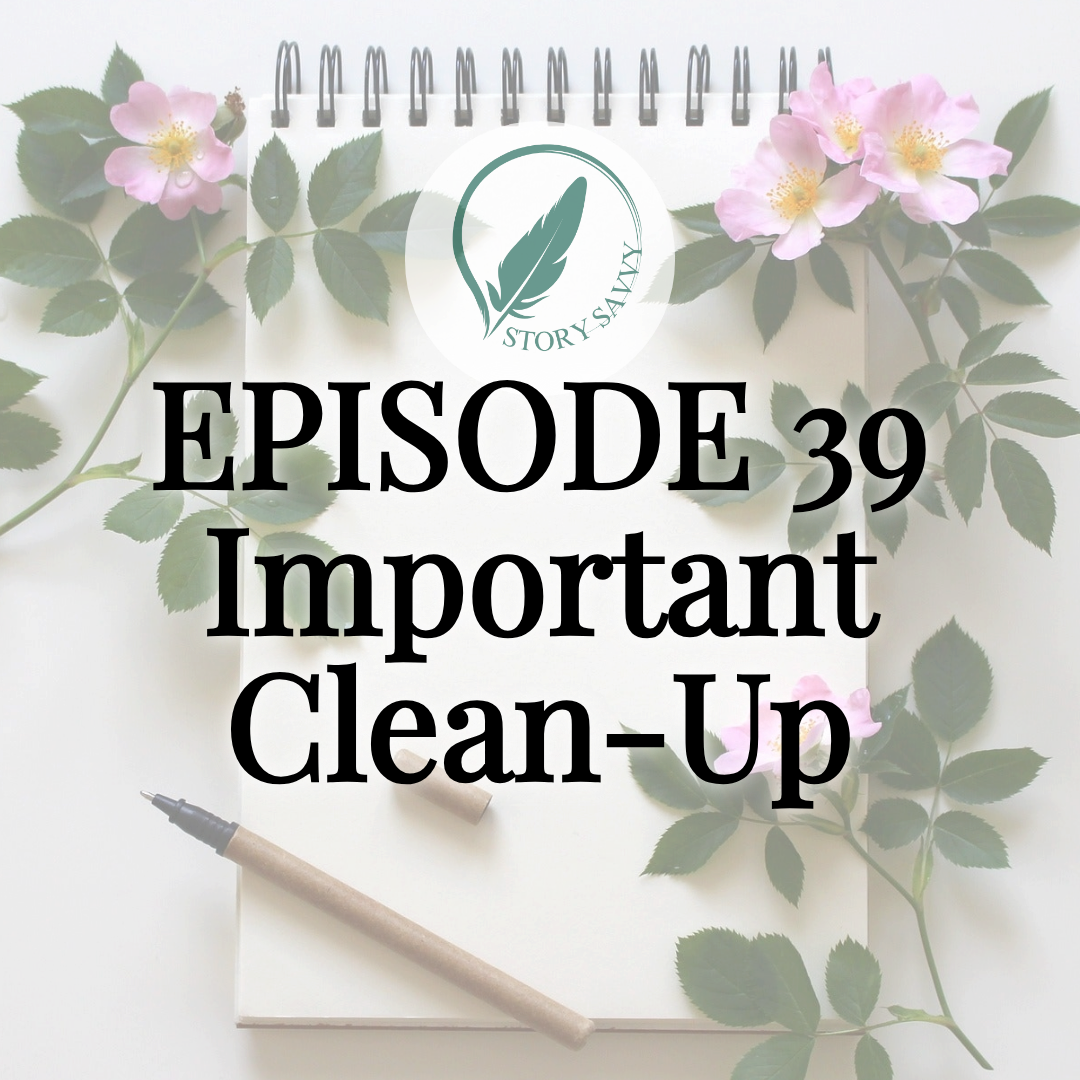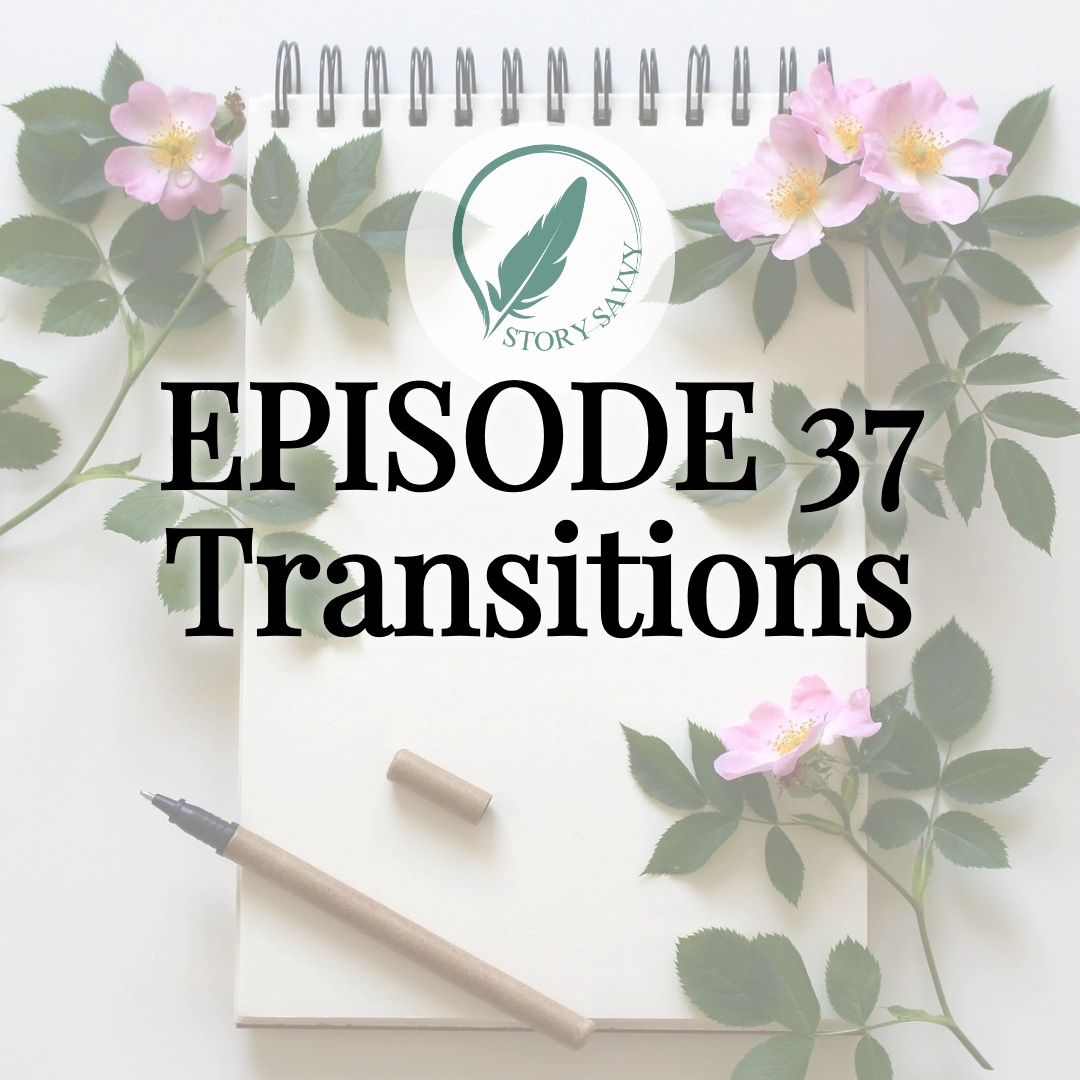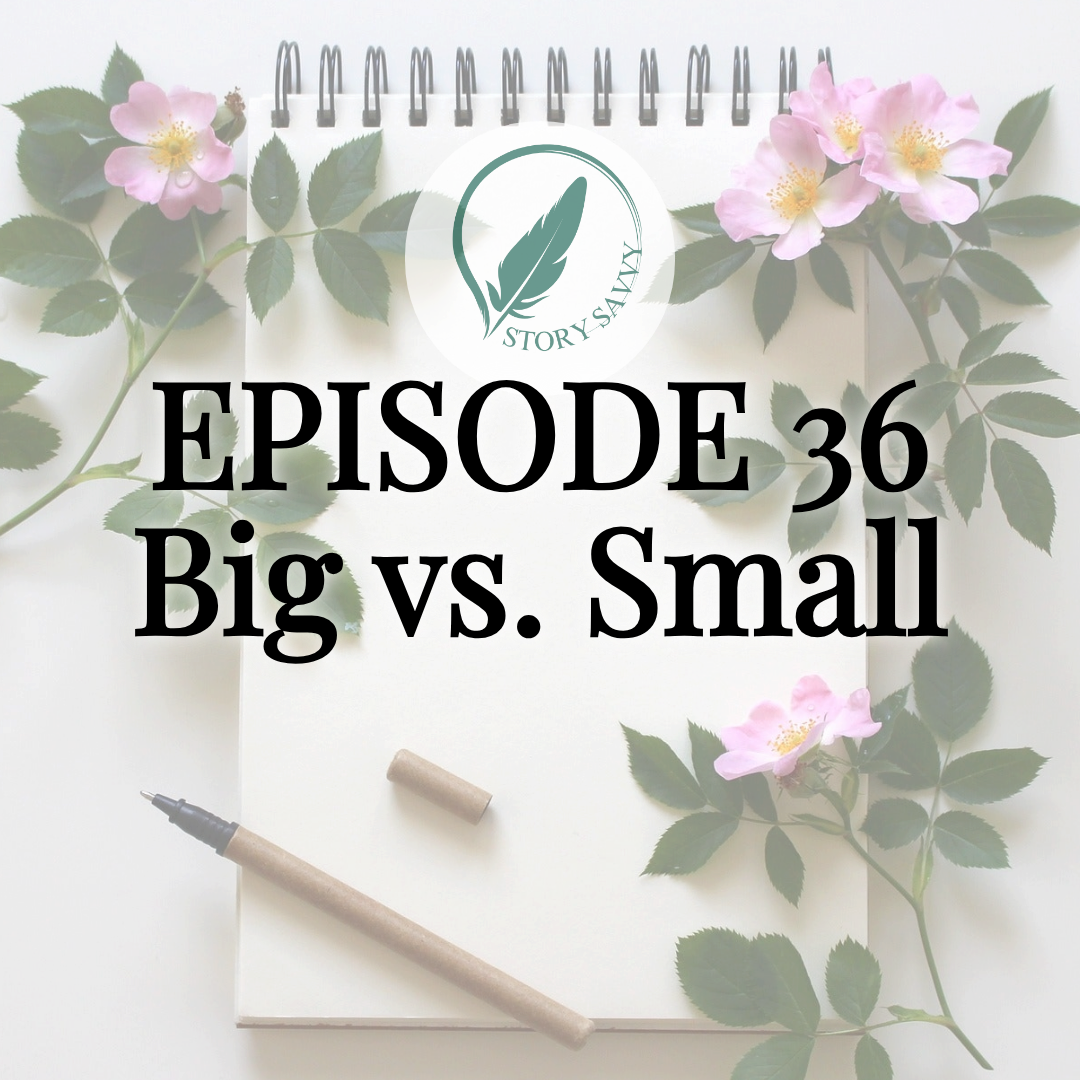The Heart of Your Story: Story Savvy Self-Editing 4
This is the big, scary, bogey-man episode! Brace yourself... 💖
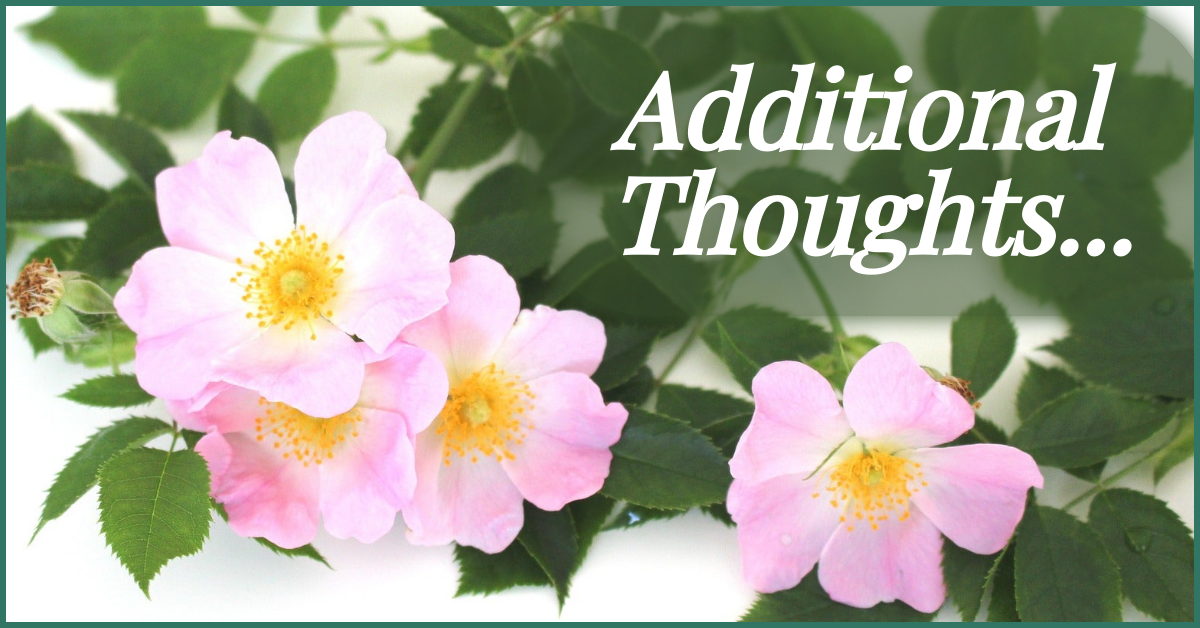
I'm not satisfied with my descriptions of what makes for a prescriptive or cautionary story, so here is a more succinct description with minor added elements I forgot to mention. Prescriptive: The protagonist makes the right choices, and is rewarded for it. Cautionary: The protagonist makes the wrong choices, and is punished for it.
Want to dive deeper into double-factor problems, which I mentioned in this episode? Check out the Story Grid episode on the topic! https://storygrid.com/epsisode-269/
If you are experiencing misalignments between your genre definition you picked in episode 2 and your core story statements, as I go into in this episode, then Episode 25 on Subplots & Plot Threads might helpful to you in figuring out which is the primary plot, and which is secondary.
For clarity, when I talk about misalignments between the different statements, using that mention of cautionary messaging, I am very specifically referring to misalignments within your one main plot, and the one defining moment of that main plot. There are absolutely ways to have a bitter win or silver-lining loss through the climax and resolution of a story, and for the main plot and a major subplot to have misaligned outcomes over time, sometimes to great effect. Checking for alignment on just the one core moment of the story is just one tool to use when trying to get three working “heart of my story” statements, and shouldn’t be interpreted as a hard requirement for the global story structure.
I hope that all adds helpful context to the episode, whether you've listened to it multiple times, or are about to for the first time!
Episode 4 Overview:
The Heart of Your Story
“What is the core heart of my story? Why should I name that, and what do I do with my answers?”
If you are self-editing your novel, and want to know what makes a good story great, then you’ll want to watch this interview on how to find the central message of your story in this 4th episode of the Story Savvy Series, where the Hart Bound Editing Podcast teams up with Authors Alcove to dive into identifying and articulating the heart of the story.
In this 52 week series, we help writers turn their good story into a great one, while Agnes Wolfe of Authors Alcove [http://authorsalcove.com] asks a developmental editor, Rebecca Hartwell of Hart Bound Editing questions on various topics that offer assistance to writers in their self-editing journey. Their conversation provides actionable guidance for authors aiming to improve their craft and create meaningful, impactful stories.
This episode dives into questions like:
- What is the heart of your story, and why does it matter?
- When is the best time to focus on your story’s core message?
- Why is it important to know your core event, core character change, and your story statement?
Rebecca also discusses the importance of self-editing and offers practical methods for brainstorming and refining your story’s deeper themes. With her expertise, she highlights how discovering the heart of a story can help writers align their characters, plot, and theme.
Recommended Resources:
- Agnes Wolfe's Insights: Tips for aspiring fantasy writers: [http://authorsalcove.com]
Have questions about defining your story’s core? Share them in the comments, and Rebecca and Agnes will answer them in a future episode!
See you next week for episode 5:
Non-Negotiables
Episode 4 Transcript:
The Heart of Your Story
Rebecca Hartwell: Hello and welcome to the Hart Bound Editing Podcast. This is episode 2 of the weekly Story Savvy series, where we tackle the 52 biggest self-editing topics and tips. Our goal is to help you make your good story great as an aspiring author asks me, a developmental editor, all of the questions you've wanted to.
So far we've covered knowing who you're writing to, picking the right genre, and using your genre choice to make your story stronger.
Today we move from external considerations to one of the most internal: the heart of your story. By the end of this episode, you'll hopefully feel even more in love with your story or idea, and confident in how you can better center it for your own satisfaction and your readers.
Agnes Wolfe: Hi, my name is Agnes Wolfe, an aspiring fantasy author who hopes to release her first middle-grade fantasy later this year, and also the host of Authors' Alcove. I'm here to dive deep into how to define the heart of our stories and why it matters with a developmental editor who has helped dozens of authors refine their books. Hi, Rebecca!
Rebecca: Hi. So Agnes, based on the last few episodes, what have you come up with for your goal audience member, your setting genre and content genre, and what are a couple big obligatory moments or elements for those genres that you're aware of?
Agnes: Okay, so my target audience is a 14-year-old girl—or 14-year-old, I think girl because the main character is a girl, so I think that would be like my target audience. My genres are middle-grade dragon fantasy as the setting genre, and epic adventure, of course, with the emphasis of that bond of dragons and humans as my content genre and subplot. I'd say the three requirements I'm going to try to meet are that my dragons have a telepathic connection with special humans. My protagonist will be on a grand adventure across the land. And that my main protagonist learns that creating peace is not about silencing yourself, but about standing up for what you believe in.
Rebecca: Solid. Then I am going to jump right in the deep end of this new topic and drag you with me to get your unprompted answer on this. What would you say is the heart of your story?
Agnes: I would say that my—the heart of my story is that—I think it goes back to what my tagline is. It would be "sometimes to make peace, you have to start a war," and it kind of goes back to my—I'm just going to share a little backstory—is that, growing up, I always was a peacekeeper. Which meant that I kept peace at all costs, and what I had learned through that is that it causes chaos. So, I wanted to write a story that had the heart of that; in order to achieve peace, sometimes you have to learn to have a voice.
And so, I wanted my main protagonist to be able to learn that she has to use her voice in order to be able to create true lasting peace, and that I also wanted to teach, you know, like, that sometimes when you're trying to keep the peace, you're actually causing—you're causing chaos. So I realized I don't actually want to keep peace, I want to make peace, and so I guess the heart of my story would be that Amelia, my main character, learns to not only find her voice but that true lasting peace can only be achieved if you are willing to fight, or in her case, start a war.
Rebecca: Great starting point.
Agnes: So, I don't know if I answered your question, so maybe we should just back up a little bit. What exactly is the heart of a story, and would you say that's what you feel would make a solid core story event?
Rebecca: So, for starters, what you just described there is a great starting point, and that is more than some authors have at your stage. So, it’s great to hear that you have that sort of basic idea of what we’re talking about here.
So, to get in a little bit more specific, when I am talking to clients about the heart of their story—and I don’t talk to all of my clients about this, it’s just the ones who need this help—what I generally ask for is three statements:
- The core story event, which is often the climax. So, the big, like, if you were to boil the story down to one scene that kind of represents what the whole story is about, what is that event?
- The second part is The core character change. This is often for the protagonist. If you have two protagonists, you can do two statements, but one of them is often going to be centered a little bit more than the other.
- And then the third part is the [The story statement.] The sort of… this is the “this is what the story is about” or “this is a story about” story statement.
So that’s sort of the starting point of where we’re going to go over those three different topics one at a time and looking at all three together as the heart of the story.
Agnes: Would you say that the heart of a story is the same as the theme?
Rebecca: If it’s helpful for you to think of it that way, then absolutely. There’s so many different takes on theme. So, if that’s how you want to interpret this, that is absolutely fine. We won’t be going into theme beyond this topic, so yes.
Specifically, to the heart of a story, one of the considerations that I really like to bring to people’s attention is this idea of a double factor problem, which is a sort of “what if”—or no, sorry, not a “what if” — but a “is it better to ___ or to ___?” And that could be something like “is it better to keep the peace, or is it better to fight for peace?” Just using what you said as an example there. And the trick for that is: when you’re coming up with this, sort of, global double factor problem for your story, or how you want to articulate what you’ve already built in the story, you have to make sure the two options are somewhat balanced. Because if the options are “Hey, is better to live or die?” or “is it better to be a good person or a bad person?”—first of all, those are too vague—but also, there’s a clear, obvious, right answer. A good double factor problem, which we’ll keep touching on through this episode, is going to have, sort of, either nearly equal good things about either choice, or nearly equal downsides to either choice. And that’s something that some people talk about being in theme, but if you haven’t done a lot of that research, if you haven’t had those conversations, then you might not be aware of that.
So, for this episode, for the most part, I’m going to try to keep things a little bit more focused on how these statements tools for your story, rather than a goal in themselves. And for this topic, the heart of your story, I really want to try to keep people inspired by this, and seeing it as a way to move forward, rather than a rule they need to follow, or another restriction on their creativity.
Agnes: Would this be the same thing as the message, or as some books call it, the “North Star”?
Rebecca: Yes, it is closer to that. So, a theme is often talked about as being, sort of, “Oh, this is a book about cowboys.” So, theme is a bit vague. Message is a lot closer to what I like to center as this heart of the story because it’s about what you’re telling the reader through what your having your characters do. It is the way you’re going to change your reader’s life or the way they think about themselves, or they think about something in their world. So, "Message" or "North Star,"—which is this idea of a concept that you always stay centered on as you move through the story—is a lot closer.
Agnes: So, I know for me, I had decided on the heart of the story before I even—like, I guess I had the characters created since college. And then the heart of the story is when I was like, “Okay, I actually have a story that’s worth reading.” But as far as other people, at what point should they name what they think it is? And how should we phrase that answer?
Rebecca: Based on my own experience as a writer, and all the authors and writers I’ve talked to on the topic, I strongly suggest that you do not think about this during drafting, as much of this advice is, because this is a self-editing series. You can consider it, if you want to, during the planning stage. What I do for myself is I’ll usually just brainstorm a couple of ideas and let them sit in my word doc, or my notebook, or whatever. Where this really comes in, is 99% in the self-editing period. Because this is much less, “Hey, this is what I want to do,”—although if you have a strong version of that, great—this, for our purposes here, is much more about, “How can I take what I have created already, and name what’s at the heart of it so that I don’t lose that, or so that I can strengthen it if it needs that?” So, for example, how I would phrase these different things—and again, this is having read and pulled out what’s already there:
- For The core event. The statement might look like, “The protagonist sacrificed themselves to save the other from the villain and escape the compound for good.” So that has some big concepts—self-sacrifice, saving the person they love—but it’s also specific to this story. It is: “I know that I have two protagonists in this story, who want—each have to save the other. It’s not one-sided. And the villain has them kept prisoner in his compound. So, the core story event is them making those sacrifices, which reflect their character arc, but it’s not about that necessarily, and they escape this compound.
- Then The core character change statement for this same book—and I’m using one of my own novellas as an example here because it’s easy in my brain—the core character statement might look like, for my female protagonist, her statement is: “She changes from being passive and afraid to proactive and brave.” And then the core character arc statement for my male protagonist would be: “He changes from vengeful and compromising to forgiving and resolute.”
- Lastly, The story statement, So, what we were talking about of theme; “This is a story about ___,’ would be something along the lines of: “This is a story about becoming a better person to save the one we love most.”
And those are the templates, the frameworks, that I will give people to try to fill out if they really need to do this work in their story, is:
- For the core event, it’s just: “Hey, [the protagonist name] takes an action which results in [big result].” So that’s the template for that statement.
- And then the template for the character arc change is: “[Character name] changes from [list their massive, major flaw or two] to [and then name the opposite that they growth into].”
- And then lastly the template for that core story statement is: “This is a story about ___[and then you write out whatever that core, you know, lesson learned, or action taken, or change enacted, is for the story].”
Agnes: So, I’m going to throw this question out there, it’s: I’m writing a series, and I know that each of my books definitely has a heart of the story. And they’re each slightly different, but they follow the same theme. Should there be a separate heart of the story for each book, and then also the series as a whole?
Rebecca: That is a great question. And yes, I do recommend that. Slight caveat; there are two different kinds of series. There are dynamic series, which I believe you’re writing, where it’s following one protagonist, or one set of protagonists, across a large arc that takes multiple books to tell. So, I’ll answer for that, but I just want to acknowledge that there are also standalone series, where each book is kind of its own contained story, but they’re all connected, where each set of protagonists just know each other.
So, answering for a dynamic series, absolutely. Because you want that journey to coherent from start to finish, and there is going to be one biggest event in the whole series. It could be at the midpoint, where everything changes, it could be the climax of the last book. But knowing what the defining single chapter, single scene event is for that series is valuable.
For the character arc, you need to know how they’re changing from the beginning of book 1 to the end of the last book, so there’s a character statement there.
And your “this is a story about ___” statement can apply to the whole series without applying to the individual books, or it can apply everything in the mix.
I recommend that if you’re going to do this exercise for your series, awesome. But then make sure that you’re also doing them—especially the core event and character arc statements—for each individual book as well.
Agnes: Okay, thank you very much. So, now just tying this into what we’ve already learned—we’ve learned about audience, and we’ve learned about genre, and subgenres. Tying that all together, what if our story doesn’t fit with one of the elements we’ve already covered in our previous episodes?
Rebecca: Yeah. So, that is often where the resistance comes in, of going “Wow, I thought I had the right answers, I thought I had this figured out, but now…” I’ve introduced, you’ve introduced whatever, more dissonance in that. So, the quick answer, I guess, is: first, make sure that you picked the right labels for your book. Sometimes naming the heart of your story will allow you to more clearly see that “Oh, I didn’t actually write dark romance. I thought I was writing dark romance, but having named the heart of the story, it has nothing to do with dark romance. Maybe I actually wrote a thriller that has a dark romance subplot.” So, use your heart of the story statements to check that you used the right labels and see if maybe adjusting those can bring things into alignment.
Second option is connected to that, and it’s basically: make sure that you actually wrote the story that you meant to, and that you think you actually wrote. So, the options there are you can either change how you’re seeing the story, which would then mean revisiting those labels, or you can consider changing the story to fit what you meant it to be and what you are labeling it as, and what you want to label it as based on that heart of the story statement.
Thirdly, assess how you could just interpret either the story or your statements differently. And I know I’ve touched on this before, I’m sure I will touch on it a hundred more times: whenever we’re talking about this story stuff, none of it as concrete as I think it is easy to see them as. So, if your genres are, let’s say, paranormal romance and as your setting genre, and just pure romance is your content genre, then if your story statement is something like—I am going off the cuff here so bear with me—if your heart of the story statement for the “this is a story about _” statement, is something like “this is a story about a wizard war,” that doesn’t connect with your content genre. But maybe you can just rephrase that statement as, “This is a story about”—I don’t know. Like—“conflict. This is a story about two wizards falling in love and they can’t be together because of war.” So, just looking at you could interpret either the answers that you have from our previous episodes, or the ones that you create with this one by tweaking a couple of words or just looking at it differently is the third option for trying to square those so that they all match.
Agnes: And like, if we wanted to know if we have the right audience, the right genre, how can we check that we wrote down the right thing as the heart of our story?
Rebecca: So, it’s definitely trickier with this one, than with the others where the answer is “You do research! You read other books.” This one takes a lot more, sort of, introspection and just meditating on it. Doing whatever crafts, or driving, or whatever kind of just gets you in that headspace.
The slightly more analytical answer to that is: make sure that you are… how do I want to put this? You can tell that it’s—that you’ve picked the right statement if you look at the major moments of the book, like the climax event, make sure that that event matches your other two statements. Make sure that the character arc matches the other two statements. Make sure that the story statement matches the other two. So, if those are on the same page, that’s a great starting point.
And then beyond that, just make sure that the plot, character, and theme are all saying the same thing to the reader. So, if your core event is, let’s say, “the protagonist makes the wrong choice and their parent dies.” That is out of alignment if your story—sorry, if your character arcs statement is something like: “My protagonist learns how to truly sacrifice himself for love.” That’s a mismatch. The first is telling the reader “Hey, whatever this protagonist did was the wrong thing. All of the choices that he made were the wrong choices because it led to this massive loss. Whereas your character arc statement is talking about this triumph, this win, this betterment.
So, yeah. Just making sure that they’re saying all the same things to the reader, and that these statements are true to what’s actually on the page. Because I know this for myself—and I actually run into this most when I’m like writing my blurbs, is—I will just get into that creative headspace where I’m tweaking and reiterating, and brainstorming, and I come up with this awesome set of statements, and then I’m like “Wait a second. This is a great set of statements, for some story, but that’s not actually the story that I wrote.” So, just making sure that it’s true to the reality that you either have, as the draft that you’ve already finished—hopefully by the time you’re doing this series. By the time you’re self-editing—or by what want it to be, is that step. And for the “what you want it to be,” that’s a matter of just accepting that you’re going to have to do a lot of editing to get the story to actually match.
Agnes: So, I hear—from what I hear of you, it’s a lot about being consistent. Making sure that you—that what you’re saying is consistent inside your story. Is that correct?
Rebecca: Absolutely. Yeah
Agnes: So, what do you mean by: what we want to be on the page? What should we do if we really put in the work and come up three great statements for the heart of the story, but it’s different from what we have in our work? And where do we even start when we start doing this self-editing with that?
Rebecca: Wel first of all, take a deep breath. And understand that’s it’s all okay. We will teach you to break all of that stuff down into much smaller, much more bite-size pieces. The step that I’m hoping folks will get out of this episode is just an awareness of it, and a willingness to go do that brainstorming. And if you come up with the answer of “Hey, I love these statements, but that’s not what I actually wrote,” then—
So, the process that I recommend, and I’ll introduce this here—I’ll probably talk about it again because this is how I suggest everyone approach all of the bi issues—is reread the story as it’s written and don’t touch anything. Don’t fix typos, don’t take notes, just speed read it like it was a novel that you could not care less about. So, speed read it, shelve it, don’t touch it, and then go back to whatever inspired you. That can be, you know, stuff in your own head. Just things that you were processing. This could be Pinterest board, music playlists, TV shows, movies, other books.
Whatever it is, go back to those inspirations, and while you’re consuming them, that’s when you start taking notes. Because you need to let your brain sort of process these really big things. And you need to that in a way where that pressure is totally off. And when your brain opens up again, that gap of “oh, yeah, I totally forgot to, you know, consider this element or I totally forgot to remember that this character existed,” whatever that gap is, if you’re having these thoughts and doing this work while you’re consuming some sort of inspiration, those gaps are going to fill so fast. And it feels a lot more productive, and it feels a lot less scary.
So, after that, the next step is: (again, you’re not touching the manuscript.) Plan how you could possibly make these massive changes, or rearrange things, fix, things, whatever approach you are feeling inspired for or confident in. And write out how you could do it, and from that how you plan to. And then set that aside again. And you’re going to do this at least once but wait until you have a plan for how you’re going to change things. And I recommend staking, like, “Alright, here's ten editing topics, or ten editing episodes in this series, that I’m going to tackle. And I’m going to make a plan for all of them and then go apply them all at once.”
First of all because this saves you a ton of time, and second of all because this will save you from a lot of “Okay, well, I fixed plan A, and then that introduced a lot of issues with plan B.” So when you do all of the planning separately, and make sure that all of your planned fixes don’t introduce massive new holes, you’re going to be miles ahead of a lot of folks.
Agnes: So, something that I have heard, because I listen to a lot of podcasts on writing, and listening to a lot of developmental editors, I’ve interviewed a lot of them, and the thing that I hear most frequently, you just said, is “set your book aside.” And that’s, I think, huge. So something that you had said that I think I have not done that I really like is that you just said to read it really fast as if it was just a book you were reading, and I have not done that! And I like that idea, because I’m always finding, like, “Oh I need to change this, oh I need to change that,” every time I pick up the book. And like I keep thinking “I just need to just read it to see, like…” And so I really like that you said that.
But going back to questions, what's the biggest payoff we are going for in all this around knowing and presenting the heart of our story?
Rebecca: All right. So the purpose of having this answer, and we've already touched on some of it, of just knowing what needs to change in the story if something isn't aligning, is the momentum of the story, to some extent. Because these answers will help you subconsciously.
So, you don't even have to learn it. You don't have to think about it. If you have this answer in your head, you will, without having to put in the extra work, build up better plot intrigue throughout, which is momentum.
If you know, “hey, that's the big story event that's sitting out there”. And you know that each scene, every paragraph in the book leading up to that is headed in exactly that direction, then that's going to come through in the writing. That's going to come through in what you're describing and how the characters are talking about it. And all of that is the healthiest form of story momentum out there.
Again, related to momentum, character investment counts for a lot. And this was a mistake that I made in my early work, which I see in a lot of people's first books, is: they don't let the reader get attached to the character strongly enough that they feel they need to find out what happens to them next. So having your heart of the story character statement of, “hey, my protagonist changes from these flaws to these virtues,” and you're thinking about that in every scene, every chapter, every paragraph, then you're going to give them a lot more depth. And because these sort of change arcs are what we experience in real life, you're going to much more easily and quickly get your readers very invested in, “oh, well, I've felt sort of passive and afraid in my life. And I can—I understand that there are places and times where it would have been a lot better if I could have been proactive and brave. So, I'm going to wait and see how this character, how Demetria, ends up making that change and how that works out for her.” So again, just knowing what your statement is, your subconscious is going to help that come through, and it's going to create much better momentum there.
And then for the, “this is a story about ___ statement,” that gets, that gets a little bit more like meta and super nerdy story structure than I really want to get into in this series. But it's going to give your story soul. If you just know that “Hey, this is what this story is about.” Again, you don't have to really consciously put in the effort into showing that as much as maybe you think, because it will come through. And, and that is going to help readers stay stuck into the story.
So, beyond momentum, knowing these statements is about delivering ending payoff. And I seriously cannot overstate how vital that is to a story that works and that will get people finishing it, closing that last, you know, page and going, "Oh my God, I need to tell my friends."
So, having these statements are going to help you deliver bigger emotions, better emotions, more, you know—like I mentioned earlier—life-changing, sort of, takeaways from your story.
So for, for what you'd said about what your story is about, your audience member, that 14-year-old girl that you have in your head when you're writing the story; if you are strong enough on these hearts of the story statements, she's going to come away from it going, "Oh, I learned something about human nature. About the value of acting in certain ways or making certain sacrifices," or whatever that is. So, delivering that catharsis and feeling changed by the story is just absolutely—just vital.
And I will take a little detour here to talk about: there are basically two kinds of story endings, as far as that payoff and catharsis goes. The first is prescriptive. So, this is any story where the protagonist makes the right choices and wins. If you can say, "Oh, in this story, the protagonist wins at the end," that's prescriptive.
It's a lot rarer to see, but it can be really entertaining to read: cautionary stories are also a thing. And I often see these in thriller or darker genres. And that's where you follow the protagonist going through their change arc and the major event and the story statement. And it's all to build up to show that, "Oh, they messed this up. They made the wrong choices. They became a worse person," whatever that is. And those stories can also deliver catharsis. They can deliver that ending payoff of, “oh, well, I've made different choices in my life, so it's going to work out better for me than it did for them.”
So, there are two options. You don't have to win at the end, but you need to make sure that if your arc is positive, the payoff is positive. And if the arc is negative, the payoff is negative. And having your story statements will help with that.
Agnes: So how about thinking about elements like symbols, imagery? What elements could we use to bring the core theme to the surface? And how can we do this effectively?
Rebecca: So, yeah, that's what most people think of when we start talking about message and theme, is this symbolism and the imagery and the metaphors and all that kind of stuff.
But while those things can be fun to play with, they aren't a part of the story as much as they are window dressing on it. So instead, I recommend that people use more integrated elements to deliver the theme or whatever you want to call it.
We've already talked about that, maybe without realizing it, because when I'm talking about the heart of the story, I'm talking about major plot action moments and character change, which requires choice, before we even get to that story statement of “this is a story about ___.” And that scales down to every level.
When you're talking about the major moments in the story and the small ones that connect those major moments, using your plot action and your character choices to talk about this theme—to show it, ideally, because "show, don't tell" does apply here to some extent—you don't want to just open the book with "this is a story about whatever it is." You want to explore it. You want to show how these themes are being experienced. So doing so through plot and character is a much, much stronger way to do so.
For example, let's go back to my novella example that I was talking about earlier. If my story statement theme is "this is a story about becoming a better person to save the one we love most," then I'm going to deliver that message in every scene by, let's say, having a protagonist make a small choice which shows the flaw that they'll have to overcome later to become that better self. Or I'll introduce an unexpected threat to one of their lives through the plot action. Or I will show them being blind in a small or big way to their own flaws in a way that endangers the other one. And I'm going to do so in escalating ways up through each scene in the story until it reaches a point where they have to change and make a different choice than they had up to that point.
But I'm digressing a little bit. So, beyond the plot and characters, some other things to consider in delivering your theme, delivering your heart of the story, could be picking a setting which will force these issues to come up. For example, if your story is about women’s rights, placing this around the suffragette movement around the turn of the 19th century is a great choice because that setting is going to force these topics to come up. If you want to talk about decadence and the fall of power, then setting it in ancient Rome—towards the later end of ancient Rome—is a great choice because that setting forces this theme to come up and be addressed and wrestled with.
Another consideration could be your supporting cast. So if your main character is dealing with, “well, how do I become braver?" then having their best friend and the fruit merchant and whoever else is in this story—again, subtly, you don’t want to overstate this—but subtly dealing or wrestling with that same question, but in a different way, in a more boring way, in a smaller way, however you need to frame that so that they don’t take over the story and overshadow the protagonist, is another great way to just consider how you can get that theme in there in a way that actually matters.
So, when in doubt, look at how every moment of conflict, or surging forward in the story, or stumbling back in the story—because there should be both—or mentorship, or internal change can connect in some way, however small, to one of those core heart statements. Because hopefully, you have them all aligned so it’s kind of one path that everything is on.
But adding on to that, and very much connected to that, I just said, you know, that path that they’re on: none of these statements are entirely static. And especially if you look at the character statement, it’s "so-and-so changes from this state to that state." That is a path. That change is not going to happen in one scene or at one moment. So, when you’re thinking about these heart-of-the-story [elements], when you’re starting at the beginning of the book, understand that they’re out there on the horizon.
And when you’re writing these elements to sort of connect into them and bring them to the surface, it doesn’t have to be that the protagonist standing in chapter one is already connected to that thing out there in the future. It just needs to connect to the path between the first sentence of chapter one and eventually getting to that core event, or the point where they actually have that change, or where that theme really comes into its own and gets wrestled with.
Agnes: Okay, so now, we don’t have very much time, but I want to be devil’s advocate for a second. Do we really need to know what the heart of our story is? And what if we don’t bother naming it?
Rebecca: Sure. Valid question. And especially since a lot of writers, and editors, and authors, and whatever don’t care about this and don’t go through this process. Especially, I’m aware that there are massive, big-name authors that literally everyone has heard of who, when asked about theme, or message, or whatever you want to call it, absolutely swear up and down that they don’t have a theme, they don’t think about message, and this isn’t part of their stories. And if people want to put it in there for themselves, that’s fine.
But the thing is, if you’re listening to this podcast, you probably aren’t one of them. And my job is very often teaching people who are either just starting off or want to get to that point, having already done this for a while, how to consciously learn, quickly, what those bestseller, world-famous authors have subconsciously learned over decades of practice.
So yeah, you don’t have to do this exercise. You could instead write 30 books over the next, you know, 50 years and figure it out subconsciously, like we were talking about with meeting our genre promises—if you read enough, this stuff is in your head somewhere subconsciously. But that’s also part of why I recommend you don’t worry about this too much until the self-editing stage, because your subconscious has something to say. And it’s going to say it without you thinking about it as you’re writing the story.
So, this process is far more about looking back at what your subconscious wrote and pulling it into a conscious awareness of it so that you can just bump it up and make it even stronger and more satisfying.
And I’m just going to add in that I promise this is the biggest, scariest thing we’re going to talk about in this whole series. Everything from this point on is going to help make sense of what we’ve discussed here and reassure any authors listening that they really can handle all of this. We’ll break down how to tackle these massive, overwhelming things into small, actionable bites.
So, in the depths of this overwhelm, and having discussed this a little bit for the last however many minutes, what are you [Agnes] now going to say your three "heart of your story" statements are now?
Agnes: Okay, so first, that we need to stand up for what we believe in. Second, we need to find our voice—which I feel is very similar. Maybe too similar, I’m not sure. And third, that peacekeepers never truly achieve peace; they just give a feeding ground for chaos. Which is something I strongly believe.
Rebecca: Cool. So, what would you say is the big core event of your story, if you had to pick one scene, one major thing that happens?
Agnes: It is when my main protagonist has to basically defy all of the people that she has been under the control of, is under the control of, to rescue her dragon.
Rebecca: Great. And how would you say your protagonist changes from the beginning of the story to the end?
Agnes: At the beginning, I’m hoping that I’m doing this well, but I’m hoping that people see that she’s kind of meek, mild. I wrote her very much like myself. Her natural instinct is to be quiet. And then I’m hoping that they can see that that inner strength really grows in her and that she has confidence in herself to do what she needs to do to make sure that the people she loves, specifically her dragon in this particular book, find safety.
Rebecca: Great. And then if you were to use that template that I introduced of: “This is a story about blank"—how would you fill that in for your story?
Agnes: I would say that “this is a story about somebody learning to fight for themselves and the ones they love.”
Rebecca: Great. Solid. I love that.
Agnes: Well, thank you so much for your insight. It has helped me so much. I really do appreciate it.
Rebecca: Of course. There is a reason that I talk about these things as the heart of a story, and I hope that anyone listening is at least feeling as much inspired as they are overwhelmed. Because this can be inspiring if you approach it with that mindset.
Ans like I said, next week, we’ll start breaking things down into smaller, much more manageable, sort of tangible tasks to use in tackling the big philosophical questions like this.
So, I would like to thank our listeners so much for following along. If you could help us out by liking and subscribing to the Hart Bound Editing Podcast and the Authors Alcove Podcast, we would be very grateful. And you can find lots more content for fantasy authors and readers beyond this joint series in those two places.
Agnes: And I can’t wait to start breaking this down. I do know the next episode I am very eager for, because I asked her a clarifying question, and she’s like, "Well, we’re going to figure it out live." So, you guys will figure it out with me, and I’ll see you next week.
Rebecca: Thank you so much for listening to the Hart Bound Editing Podcast. I look forward to bringing you more content to help you make your good story great so it can change lives and change your world.
Follow along to hear more, or visit my website linked in the description to learn how I can help you and your story to flourish.
See you next time!


